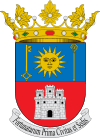Telde
| Telde | |||
|---|---|---|---|
| Municipality and city | |||
| |||
 Telde | |||
| Coordinates: 27°59′N 15°25′W / 27.983°N 15.417°W | |||
| Country |
| ||
| Autonomous community |
| ||
| Province | Las Palmas | ||
| Government | |||
| • Mayor | María del Carmen Castellano Rodríguez | ||
| Area | |||
| • Total | 102.43 km2 (39.55 sq mi) | ||
| Elevation | 130 m (430 ft) | ||
| Population (2009)[1] | |||
| • Total | 100,015 | ||
| • Density | 980/km2 (2,500/sq mi) | ||
| Demonym | Teldenses | ||
| Time zone | CET (UTC+1) | ||
| • Summer (DST) | CEST (UTC+2) | ||
| Postal code | 35200 | ||
| Official language(s) | Spanish | ||
| Website | Official website | ||
Telde is a municipality in the eastern on the island of Gran Canaria, Canary Islands, Spain. The suburb of Las Palmas city. It is the second most populated municipality on the island, with a population of 100,015. The city is the oldest and the first capital of the island of Gran Canaria, founded before 1351.
It is located on the province's main highway, which links with the capital and the superhighway GC1, other roads includes GC4 with mountain curves in the northeast and GC5 near Telde and another interchange in the east. In recent years, the main industries have become private businesses and tourism, though until the 1980s agriculture was the dominant industry. The Atlantic Ocean is to the east, farmlands cover the central and eastern area, and the rest of the land is very mountainous. The housing developments of Las Palmas de Gran Canaria were built in the 1960s and were expanded in the 1980s. This expansion resulted in a loss of agricultural land which was replaced by residential, industrial and commercial properties, including hotels and an airport, Gran Canaria International Airport. The airport is located in the subdivision of Gando, south of Telde. Further south lies the island's tourist zone.
History

Pre-Spanish colonialist invasion Telde was the eastern centre to the aborigenes of the island, and the renowned aborigen Doramas is believed to have lived here. Telde, situated in a most fertile area of Gran Canaria, has its equivalent province in Morocco in a very fertile region called Tedlah. Early records point to about 14,000 aborigen dwellings here in Telde at the time of conquest, and Telde is the spot where the famous Idolo de Tara figure—currently housed in the Museo Canario in Las Palmas—was discovered.
Createde by papal decree 1351. Today Telde is Gran Canaria's second city with a population well over 80,000. The historic old town area of Telde is particularly popular with visitors.
In the past, Telde was an agricultural community, the main crops being sugar canes, vineyards, bananas and tomatoes. Today, the surrounding area of Telde is quite heavily industrialised becoming the industrial centre on the island.[2]
Iglesia de San Juan Bautista de Telde is the true spiritual centre of Telde. Located in the square of the same name and founded in 1483, the old church was erected by the Garcia del Castillo family at the time of the town's foundation. It still has the original gateway, an example of Sevillian-Portuguese Gothic architecture. The towers, however, are an example of early 20th neo-Gothic construction. The real marvels are inside the building: the statue of Christ on the main altar, made from corn dough by the Tarasco Mexican Indians, brought here before 1550, the Flemish Gothic main altar, which dates back to before 1516, and the triptych of the Virgin Mary, brought from Flanders, also in the 16th century, depicting five religious scenes.[3]
Main sights
Iglesia de San Juan Bautista de Telde, is the true spiritual centre of Telde. Located in the square of the same name and founded in 1483, the old church was erected by the Garcia del Castillo family at the time of the town's foundation. It still has the original gateway, an example of Sevillian-Portuguese Gothic architecture. The towers, however, are an example of early 20th neo-Gothic construction. The real marvels are inside the building: the statue of Christ on the main altar, made from corn dough by the Tarasco Mexican Indians, brought here before 1550, the Flemish Gothic main altar, which dates back to before 1516, and the triptych of the Virgin Mary, brought from Flanders, also in the 16th century, depicting five religious scenes.[4]
Telde has 101 archaeological sites and 709 listed sites of ethnographic interest. The number of sites increases each year, as do new aspects of old fields, but most are in disrepair and many are disappearing. Some of the most prominent are the coastal town of Tufia in good condition and extensively excavated by archaeologists, a large cave with four doors located on top of a mountain overlooking the plain, and a village of caves with collective barn in the back, the caves of Tara and Cendro remains of the ancient center of population, the town of Draguillo on the border with Ingenio, Las Cuevas Chalasia which consist of a labyrinthine series of artificial caves linked by tunnels and the impressive Necropolis of Jinámar which includes more than 500 tombs of various types.
Sisters cities
See also
References
| |||||||

